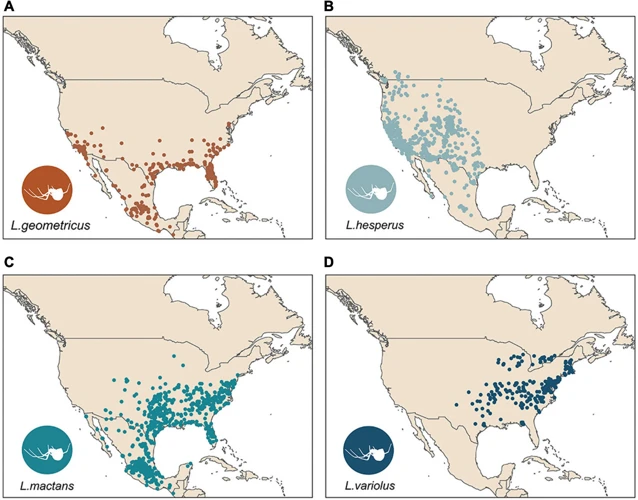The black widow spider has been a source of fear and fascination for centuries. Its shiny black body and distinctive red hourglass marking on its abdomen make it easy to identify, but what factors affect its distribution? Many people may assume that black widows are found everywhere, but that couldn’t be further from the truth. In this article, we’ll explore the various factors that influence the distribution of black widow spiders. From climate and habitat to food supply, migration patterns, and competition, we’ll cover everything you need to know about what affects the distribution of these venomous arachnids. So get ready to learn about the fascinating world of the black widow spider and all the factors that contribute to its distribution.
Climate
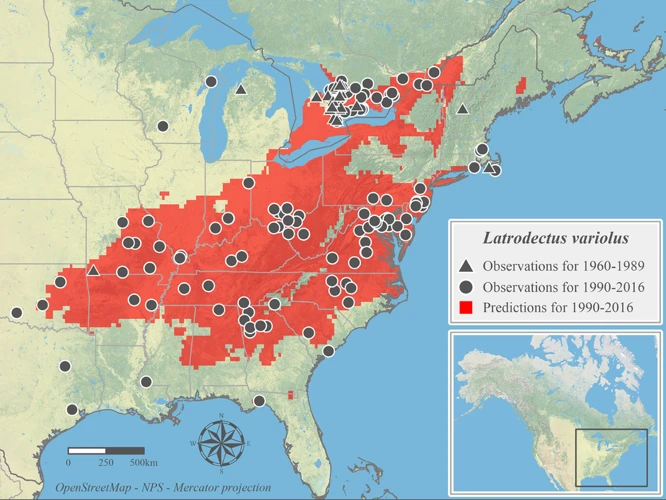
The distribution of black widow spiders is influenced by many factors, one of the most significant being climate. Temperature and precipitation patterns play a crucial role in determining where these spiders are found. The patterns of climate that occur in a particular area can also affect the black widow’s ability to adapt to new habitats if necessary. While there are many regions where black widows can be found, the prevalence and concentration of populations can be tied to specific climate patterns. In this section, we’ll explore how climate affects the distribution of black widow spiders and how climate changes may impact their populations.
Temperature
Temperature is a key factor affecting the distribution of black widow spiders. These spiders are found in warm regions of the world and thrive in areas with temperatures that range from 70-90°F. Black widow spiders are unable to tolerate colder temperatures, which limits their distribution to regions with warm climatic conditions.
Factors that Affect Black Widow Spiders in Different Temperature Zones:
- In tropical regions, black widow spiders are found in most habitats, including forests, swamps, deserts, and grasslands. In these areas, temperatures are usually moderate, and the availability of prey is abundant.
- In temperate zones, black widow spiders are found mostly in warm and dry areas such as southern regions of North America. During winter, they move to warmer areas, where they can survive low temperatures.
- In polar zones, black widow spiders are not found because of the extreme cold temperatures.
The distribution of black widow spiders is also influenced by changes in temperature, which may result from natural or human-induced climatic changes. The increase in global temperatures has led to a northward shift in the range of black widow spider populations, making them more prevalent in regions where they were previously rare or absent.
Understanding the impact that temperature has on black widow spider populations is key to controlling their distribution. By understanding the temperature conditions that these spiders thrive in, it is possible to predict the areas where they are most likely to be found. For instance, according to a recent study, wildfires led to a temporary increase in black widow spider populations in habitats that are usually suitable for their growth. Further, natural disasters can also result in the displacement of black widow spiders, leading to a shift in their distribution.
Understanding the climatic changes that influence black widow spider distribution is fundamental when addressing their population in different zones.
Precipitation Patterns
Precipitation patterns play a crucial role in determining the distribution of black widow spiders. Black widows are typically found in regions with a dry climate and low precipitation. These spiders are highly adapted to dry environments and have developed efficient mechanisms for conserving water.
Rainfall: Black widow spiders are often less commonly found in areas with high rainfall as excessive water can make their habitat unsuitable. Too much rain can lead to increased humidity levels, which can disrupt the spider’s natural habitat and make them more susceptible to predators and disease. Excessive rainfall can destroy the spider’s egg sacs, leading to a decrease in their population.
Drought: While black widow spiders are adapted to dry environments, prolonged droughts can have negative impacts on their population, especially if there is a shortage of prey. A reduction in prey population can lead to undernourished spiders and a dwindling population.
It can be concluded that black widow spiders’ distribution is closely linked to regional precipitation patterns. Populations of these spiders can be difficult to maintain in areas with either extreme rainfall levels, and favorable conditions often involve low-moderate precipitation levels.
If you’re interested in learning more about black widow spiders and their populations, check out prevalence of black widow spiders in North America.
Habitat
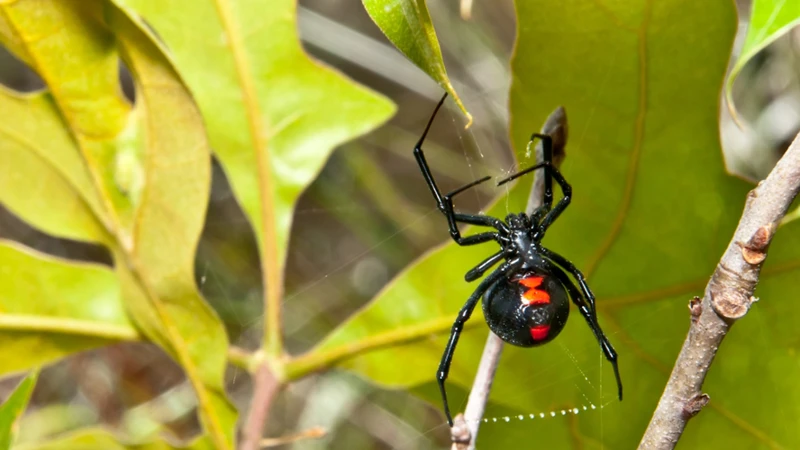
Habitat: Where Do Black Widow Spiders Live?
The distribution of black widow spiders is heavily influenced by their habitats. These spiders have a wide range of habitats, from natural environments to urban areas. However, they prefer warm and dry environments, and their distribution is limited by the availability of suitable habitat. Let’s explore the different types of habitats in which black widow spiders can be found.
Natural Habitats
Natural Habitats
Black widow spiders are commonly found in a variety of natural habitats. These habitats include forests, woodlands, meadows, and fields. They prefer habitats with dense vegetation, such as shrubs, tall grasses, and piles of debris. Black widow spiders are especially common in regions with a warm and humid climate.
The geographic distribution of black widow spiders varies depending on the species. For instance, the Southern black widow is common throughout the southern United States, while the Northern black widow is found in the northeastern part of the country. The Western black widow, on the other hand, is typically found in drier regions of western North America.
Black widow spiders also have specific microhabitat preferences. In forests, black widow spiders often reside in leaf litter and brush piles. In the desert, they prefer rocky crevices and outcroppings. Black widow spiders may construct their webs in the corners of buildings, barns, and sheds.
Black widow habitats are also influenced by the presence of other organisms. For example, they are often found near termite mounds, as their prey often congregate around these structures. However, black widow spiders may also be found in areas with fewer prey options.
It is important to note that black widow spider populations can be affected by natural disasters, such as hurricanes, floods, and wildfires. Populations may also decline due to loss of habitat from human activities, including deforestation and construction.
Natural disasters can heavily impact black widow populations as they can displace entire groups of black widows. Ensuring that black widow habitats are protected and maintained is essential for their survival, as they play an important role in the ecosystem.
Adaptation to Urban Areas
Black widows are commonly found in natural habitats such as forests, fields, and swamps. But they have also adapted to urban areas due to human activity and modifications to the landscape. This allows them to expand their territory and find new sources of prey. Urban areas typically provide a range of shelter and hiding spots for black widows, including:
- Rock piles: these provide a place for spiders to hide from predation and also retain heat in cooler months.
- Woodpiles: similar to rock piles, they provide both shelter and warmth.
- Yards and gardens: black widows often find shelter in outdoor furniture, storage sheds, and flower pots.
- Building structures: black widows can be found in building structures such as basements, crawl spaces, and attics.
- Vehicle tires: tires provide a warm and sheltered environment that black widows can use for nesting.
These adaptations have contributed to the spread of black widows in urban areas and their ability to survive and even thrive in human-dominated environments. However, it’s important to note that the presence of black widows in urban areas can pose a safety risk to humans. It is essential to identify and take necessary precautions to avoid contact with these venomous spiders.
To learn more about black widow spider populations and their distribution, check out our article on human activity and black widow spider populations and the distribution of black widow spiders worldwide.
Food Supply
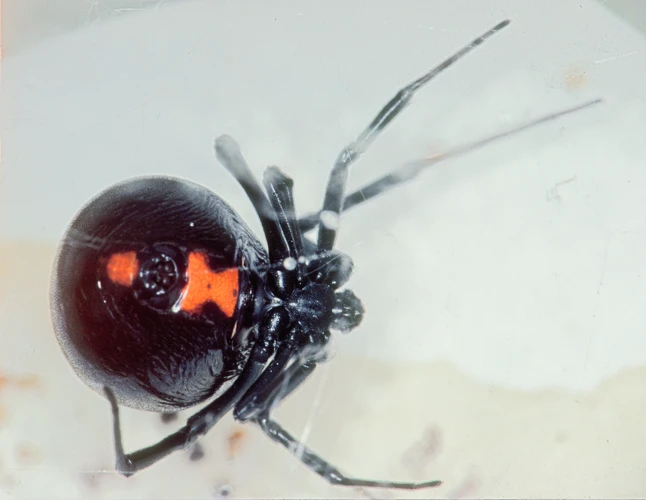
When it comes to black widow spiders, food plays a critical role in shaping their distribution and abundance. As predators, black widows rely heavily on a variety of insects and other arthropods for sustenance. The availability of suitable prey can determine whether black widows thrive or struggle to survive in a given area. In this section, we’ll explore the factors that influence the food supply for black widow spiders, along with the ways in which these spiders interact with other animals in their ecosystem. To learn more about the distribution of black widow spiders around the world, check out our global map.
Prey Availability
Prey availability is a crucial factor that affects the distribution of black widow spiders. As **strong** predators, black widows feed on a variety of insects and other small animals. Their primary diet includes flies, mosquitoes, grasshoppers, beetles, and caterpillars.
Lack of prey can limit the distribution of black widows. For instance, in areas where there are few insects, black widows may not survive since their food supply is restricted. On the other hand, in areas with high prey abundance, black widows can thrive and reproduce.
Black widows utilize their webs to capture their prey. They are known to build their webs in areas with high insect traffic, such as near light sources or around bushes and trees. According to research, black widows are attracted to locations with high levels of artificial light at night, which increases their chances of catching prey.
It’s important to note that black widows are sit-and-wait predators, meaning they do not chase after their prey. Instead, they wait patiently in their webs for their prey to come to them. This hunting behavior makes their prey availability a significant factor to consider when studying their distribution.
In areas with high prey availability, black widows can maintain larger populations since they have access to enough food to sustain their numbers. On the other hand, in areas where prey is scarce, black widow spiders may have a harder time finding enough food to support their population, limiting their distribution.
To conclude, the distribution of black widows is heavily influenced by prey availability. Understanding the spider’s diet and hunting behavior can help us identify their preferred habitats, such as dark, undisturbed areas with abundant insect populations. If you want to learn more about identifying black widow spiders, check out our guide on /identifying-black-widow-spiders/.
Predators
Black widow spiders are not only known for their venomous bites but also for being a target for a variety of predators. These predators include birds, wasps, mantids, and other spider species. Among these predators, the bird species are the most common threat to black widows. The diet of birds typically includes insects such as spiders, and black widows are a preferred snack. Smaller species of birds may fall victim to black widows, but larger ones like the raven and roadrunner have been found to be immune to their venom.
Wasp species are also a predator of black widow spiders. They use their stingers to temporarily paralyze the spider and then lay their eggs on the still-living body for their larvae to feed on. Mantids, on the other hand, are known to feed on black widows, but it’s less common as they usually stay within their own species for feeding. Other spider species such as the jumping spider are known to compete for the same prey as black widows, and occasional attacks on smaller black widows have been observed.
It’s important to note that not all spider species are predators of black widows. In fact, some spiders have evolved to mimic the appearance of black widows as a means of protection against predators or to trick prey into thinking they are the venomous spider.
Understanding the predators of black widows helps shed light on the importance of their place in the ecosystem. Despite their venomous nature and potential dangers to humans, black widows play a crucial role in controlling the population of other insects. To learn more about dangerous spider species and their differences, check out our article on dangerous spiders comparison. If you want to discover more about unusual habitats for black widows and their adaptability, head over to our article on unusual habitats for black widow spider. And for a broader perspective on global black widow distribution and their behavior, explore our article on global black widow distribution.
Migration and Dispersal
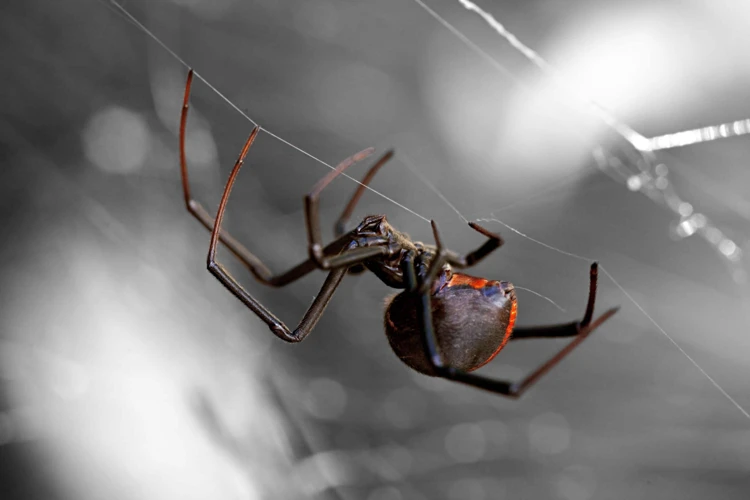
As black widow spiders have a wide range of habitat types, they often need to disperse and migrate to find suitable areas for hunting and reproduction. The process of migration and dispersal in black widow spiders is a complex one, impacted by a variety of factors that can either facilitate or hinder their movements. Understanding the factors that influence the dispersal and migration patterns of black widow spiders is essential for gaining insight into their distribution and behavior. Let’s explore some of the key factors that are involved in the migration and dispersal of black widow spiders.
Dispersal Patterns
Black widow spiders are known for their distinctive red hourglass marking on their abdomen and their venomous bite. These spiders have a remarkable ability to disperse over long distances. Dispersal is an important behavior that allows a species to expand its range and find new habitats. To better understand the dispersal patterns of black widow spiders, here are some key factors to consider:
- Environmental cues: Dispersal is often triggered by environmental cues such as changes in temperature, humidity, or light. For black widow spiders, high temperatures and low humidity are known to stimulate dispersal.
- Distance: Black widow spiders can disperse over long distances, but the exact range can vary widely depending on factors such as the quality of the habitat and the availability of resources such as food and water.
- Social cues: Some spider species disperse in groups, which may increase their chances of survival. However, black widow spiders are typically solitary and do not exhibit social behavior.
- Life stage: The life stage of the spider can also influence dispersal. For example, juvenile spiders may be more likely to disperse than adults, as they are still searching for suitable habitats and mates.
- Dispersal mode: Black widow spiders can disperse by ballooning, which involves releasing a strand of silk and being carried by the wind. They can also crawl long distances over the ground.
The dispersal patterns of black widow spiders are complex and influenced by a variety of factors, including environmental cues, distance, social behavior, life stage, and dispersal mode. Understanding these patterns is important for managing and controlling populations of these venomous spiders.
Migratory Behavior
Black widow spiders are known for their distinctive migratory behavior, which plays a crucial role in their distribution. Notably, these arachnids have adapted to moving from one place to another in search of better conditions for survival. They are known for their long-distance migrations that occur mostly during the autumn periods.
Migratory Behavior of Black Widow Spiders
The migratory behavior of black widow spiders is essential in expanding their territory widely, thus increasing their chances of survival. These spiders move in search of favorable environmental conditions, including temperature, humidity, and prey availability. During migration, black widows use different methods to navigate, including visual cues, olfactory stimuli, and direct contact with other spiders.
The table below highlights some of the key aspects of black widow spider migration:
| Behavior | Description |
|---|---|
| Long-Distance Migration | Black widow spiders move considerable distances, mostly during the autumn season, to seek better conditions for survival. During migration, these spiders travel up to hundreds of kilometers. |
| Searching for Suitable Habitats | During migration, black widow spiders search for suitable habitats that meet their specific requirements such as temperature, vegetation cover, and prey availability. |
| Integration with Local Population | When black widow spiders migrate to a new location, they often integrate with the local population. This integration allows them to adapt to the new environment easily. |
| Re-orientation at New Location | When the black widow spiders reach their new location, they re-orient themselves to identify the specific conditions that favor their survival. This behavior ensures that they establish breeding grounds and secure sources of food adequately. |
It is worth noting that black widow spiders’ migratory behavior is crucial in determining the spread of this species throughout different regions. By moving to new locations, these spiders also interact with other populations, leading to genetic exchange and hybridization.
Competitive Interactions
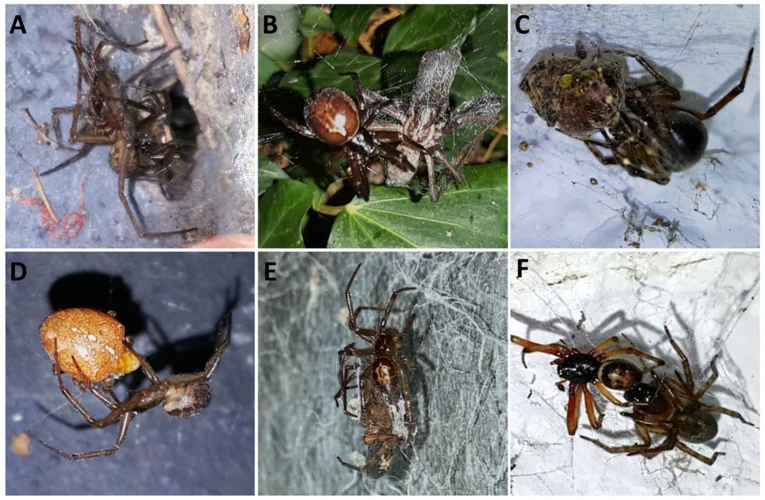
As with any animal species, black widow spiders have to compete with other organisms for resources such as food and shelter. Competitors can include other spider species, insects, and even small vertebrates like lizards and birds. In some cases, black widow spiders may also compete with their own offspring or with members of their own species during mating.
Competition with other spiders: Black widow spiders are known to be fierce predators, and they often consume other spider species as part of their diet. However, some spider species have evolved strategies to avoid predation by black widows. For example, some spiders may mimic the appearance and behavior of black widow spiders, fooling them into thinking they are members of the same species. Other spiders may spin webs that are difficult for black widows to penetrate or may release chemicals that repel black widows from entering their territory.
Competition with insects: Insects make up the bulk of the black widow spider’s diet, but they are also competitors for resources such as suitable habitat and prey. Some insect species, like crickets, can be particularly difficult for black widows to catch because of their swift movements and jumping abilities. Insects that have adapted to urban environments may also be more difficult for black widows to catch because they are more adept at hiding in human-made structures.
Competition with other animals: Black widow spiders may also face competition from small vertebrates like lizards and birds that compete for prey and territory. Some predators, such as the praying mantis, have also been known to consume black widow spiders, which may lead to a reduction in the black widow spider population.
Competitive interactions are one of many factors that can affect the distribution and abundance of black widow spiders. While black widow spiders are highly adaptable and can thrive in a wide variety of environments, the presence and intensity of competition can impact their ability to survive and reproduce.
New Challenges
As the world continues to evolve, new challenges arise that can affect the distribution and survival of black widow spiders. These challenges are often unpredictable and can pose a threat to even the most adaptable species. In this section, we will explore two of the most significant challenges faced by black widow spiders today: climate change and interspecific hybridization. Both of these challenges have the potential to drastically alter the distribution and genetic makeup of black widow spider populations.
Climate Change
Climate change is one of the most pressing issues affecting the distribution of black widow spiders and other species around the world. Rising temperatures can affect the behavior and physiology of black widows, making them more or less likely to thrive in certain environments. Here are some ways that climate change is affecting the distribution of black widow spiders:
- Changes in temperature: As the climate warms, black widows may be able to expand their range into previously too cold areas, but at the same time, they may be forced out of regions that become too hot for them to live comfortably.
- Shifts in precipitation: Changes in precipitation patterns can also affect the availability of prey for black widow spiders. Drought conditions can reduce the number of insects available for black widows to eat, while increased rainfall may lead to more competition from other spider species that thrive in wet conditions.
- Impact on natural habitats: Black widows typically inhabit dry, arid habitats, but as global warming leads to changes in these environments, black widows may be forced to seek out alternative habitats or adapt to urban areas.
- Impact on food supply: Changes in climate can also affect the availability of prey for black widows, impacting their ability to reproduce and thrive.
In addition to these direct effects, climate change can also have indirect effects on the distribution of black widow spiders. For example, changes in plant growth patterns can alter the availability of insect prey, which can in turn impact the distribution of black widows. Similarly, changes in the distribution of other species that prey on black widows, such as birds or other spiders, can also influence their distribution.
Climate change is a complex and multifaceted issue that is likely to impact the distribution of black widow spiders in a number of ways. As temperatures and weather patterns continue to shift, it will be important for researchers to monitor the distribution and behavior of black widow spiders to better understand how they are affected by these changes.
Interspecific Hybridization
Interspecific Hybridization, also known as crossbreeding, refers to the mating between individuals of two different species. This phenomenon can occur naturally or through human intervention, such as in agriculture or animal breeding. While it may seem unlikely, there have been instances of Black Widow Spiders mating with other spider species, which can have significant implications for their distribution and evolution.
Studies have shown that hybridization between Black Widow Spiders and other spider species tends to result in offspring with reduced fitness, meaning they are less able to survive and reproduce. However, there have also been cases where hybridization has led to the creation of new hybrid species that are better adapted to certain environmental conditions.
It is important to note that interspecific hybridization is not a common occurrence and the likelihood of it happening in the wild is relatively low. Additionally, with the Black Widow Spider’s aggressive and cannibalistic behavior, it is unlikely that mating with other spider species occurs frequently.
However, the potential for hybridization between Black Widow Spiders and other species should not be overlooked, especially in areas where there is a high diversity of spider species. This can have implications for both pest control and conservation efforts.
To summarize, while interspecific hybridization is not a common occurrence among Black Widow Spiders, it is a possibility that should be considered when studying their distribution and evolution. Further research should be conducted to better understand the implications of hybridization and how it may impact the future of this iconic spider species.
| Pros | Cons |
|---|---|
| Potential creation of new hybrid species that may be better adapted to certain environmental conditions | Offspring with reduced fitness, making it less likely to survive and reproduce |
| Uncommon occurrence in the wild, particularly with the Black Widow Spider’s aggressive and cannibalistic behavior | |
| Implications for pest control and conservation efforts | Further research needed to better understand the implications of hybridization |
Conclusion
After examining the various factors that affect the distribution of black widow spiders, it is clear that these arachnids are highly adaptable and can thrive in a variety of conditions. However, they are most commonly found in warm, dry habitats with abundant prey resources.
Climate plays an important role in determining the distribution of black widow spiders. Temperature and precipitation patterns affect the availability of prey and suitable habitat. Warmer temperatures tend to provide optimal conditions for black widows, while rainy or humid conditions can make it difficult for them to thrive.
Habitat is another crucial factor in determining where black widow spiders are found. They are adapted to a variety of natural habitats, such as deserts, forests, and grasslands. However, they have also shown an ability to adapt to urban areas and can often be found in and around human structures.
The availability of prey is also important for black widow spiders to survive and continue to thrive. They are known to prey on a variety of insects, including other spiders, and can even consume small vertebrates such as lizards. However, they also face predators themselves, such as birds and wasps.
Migration and dispersal patterns can also impact the distribution of black widow spiders. They have been known to disperse in search of new resources or to escape unfavorable conditions. Additionally, some populations exhibit migratory behavior, traveling long distances to take advantage of seasonal food sources.
While black widow spiders have proven to be highly adaptable, they are not immune to new challenges. Climate change can impact their habitat and prey resources, while interspecific hybridization has the potential to alter their genetic makeup and behavior.
In conclusion, the distribution of black widow spiders is influenced by a range of factors, including climate, habitat, food supply, migration and dispersal, competitive interactions, and new challenges. Understanding these factors can help us better appreciate the resilience and adaptability of these arachnids, while also informing efforts to manage and conserve their populations.
Frequently Asked Questions
What is the habitat range of black widow spiders?
Black widow spiders inhabit a wide range of habitats including forests, dry deserts, and urban areas.
Can black widow spiders adapt to urban environments?
Yes, black widow spiders are known to adapt to urban areas, where they build their webs in corners of buildings, under eaves, and in other protected structures.
What do black widow spiders eat?
Black widow spiders feed on a wide range of prey, including insects, small reptiles, and mammals.
Are black widow spiders a threat to humans?
Yes, black widow spiders are venomous and their bites can be dangerous to humans. However, bites are rare and usually occur when people disturb their webs or habitats.
What factors affect the distribution of black widow spiders?
Climate, habitat, food supply, migration and dispersal, competitive interactions, and new challenges are factors that affect the distribution of black widow spiders.
Do black widow spiders migrate?
Yes, black widow spiders have been observed to migrate to new areas in search of better resources or habitats.
What is the impact of climate change on black widow spider distribution?
Climate change may lead to changes in the distribution and behavior of black widow spiders as temperatures and precipitation patterns shift.
What predators do black widow spiders have?
Black widow spiders have few natural predators, but some birds and small mammals, such as shrews and bats, may prey on them.
Can black widow spiders hybridize with other spider species?
Yes, hybridization with other spider species has been observed, which creates new challenges for the management and control of black widow populations.
What should I do if I find a black widow spider in my home?
It is recommended to contact a professional pest control service to handle the removal of black widow spiders, as their bites can pose a serious health risk to humans.

